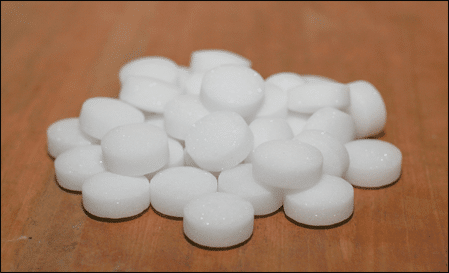Kapoor / Camphor / Cinnamomum Camphora – Classification, Ayurvedic Properties & Dosage
KAPOOR
FAMILY – Lauraceae
BOTANICAL NAME – Cinnamomum camphora
SYNONYMS OF KAPOOR
- Karpoor – Which helps in alleviating the diseases and makes overall body healthy
- Ghansaar – Which has solid extract
- Chandra – As it is cold and seems to be white as chandra (moon)
- Himahva – It is cold and white as ice

PHYSICAL APPEARANCE
- The tree of kapoor is 100 feet long, 6-8 feet broad and is evergreen.
- Bark of kapoor is rough from outside and smooth from inside.
- The leaves of this herb are 2-4 inches long, yellowish green in color, have aroma and seem to be like a tejpatra.
- Flowers of kapoor are yellowish white in color, small in size and present in blossom (bunch).
- Fruit of kapoor are dark green in color, round like peas and present n bunches, turned out black in the month of october.
- Seeds of kapoor are small in size and include aroma.
- In the season of feb – march the old leaves fall off and along with that the new leaves grow.
- All the parts of the plant have an aroma.
VERNACULAR NAMES
- Sanskrit Name – Karpura
- Hindi Name – Karpur, karpuram
- English Name – Camphor tree, Camphor laurel
- Kannada Name – Pache karpoora
- Bengali Name – Karpur
- Telugu Name – Karpooram Chettu
- Marathi Name – Karpur
- Gujarati Name – Karpur
- Tamil Name – Karpooram
HABITAT
Globally kapoor is grown in the regions of Taiwan, Japan, India, Sri Lanka, Madagascar, South Africa and USA. Taiwan is the first country which produces Karpura, then comes the name of Japan. In India it is grown in the ghats of kerala (western ghats).
MENTIONED IN WHICH CLASSICAL TEXT?
- Dhanvantari Nighantu explained Pakva (prepared) and Apakva (natural) varieties of Kapoor.
- Kaiyadeva explained there are three varieties – Ishavasa, Hima sanjnaka & Potashraya. Later he explained that there are two types based on their processing, Pakva (prepared) and Apaka (natural).
- Raja Nighantu explained around 14 types of Karpura on the basis of Rasa, Guna and Veerya.
RASA PANCHAKA
| Hindi / Sanskrit | |
| Rasa (taste) | Tikta (Bitter), Katu (Pungent), Madhura (Sweet) |
| Guna (physical properties) | Laghu (light), Rooksha (dry) |
| Veerya (potency) | Sheeta (cold) |
| Vipaka (metabolic property) | Katu (pungent) |
EFFECT ON DOSHAS
It helps in pacifying vata dosha due to its madhur (sweet) taste, balances pitta dosha due to cold potency and due to pungent properties it helps in eliminating kapha dosha.
CHEMICAL COMPOSITION
This plant has various active chemical constituents like Campherol, camphene, terpineol, borneol, linalool, thymol, and some other essential volatile oils.
BENEFITS
Kapoor almost has healthy effects on various systems of the body.
- It helps in secreting digestive juices thus helps in improving the digestive system health.
- It has rasayana (antioxidant) effects that help in preventing the degenerative changes in the body and restrict the growth of free radicals.
- The wonderful antispasmodic and analgesic effect of kapoor provides instant relief from pain, spasm and cramps.
- It has a shotha hara (anti-inflammatory) effect that helps in relieving the muscular pain and the pain due to inflammatory conditions such as rheumatoid arthritis.
- This herb is also a very good decongestant, that instantly relieves congestion and alleviates difficulty breathing.
- It is considered as a nervines tonic that stimulates the brain and improves overall brain activities.
- The vajikarana (aphrodisiac) effect of kapoor stimulates the reproductive hormones that are helpful in improving reproductive health.
HOME REMEDIES
- Pinch of kapoor with 20 ml of water reduces the burning sensation in the stomach.
- By adding kapoor in coconut oil, apply it on the affected skin in all types of skin diseases such as dermatitis, itching, burning sensation, etc.
- It is effective in case of epistaxis (nasal bleeding) – add kapoor in lukewarm cow’s ghee and administer 2 drops in both nostrils.
- If you are having a Tooth problem – rubbing kapoor powder will help with it.
- It helps in alleviating fever also – 1 pinch of kapoor, 1 pinch of hing, little amount of honey, 2-3 drops ginger, mix all these and take it twice a day.
- It is a very good disinfectant – you can burn kapoor and make your home free from infections.
- By adding sesame oil in kapoor, massage it on the affected area with pain, it will help in reducing pain.
PART USED
Niryas (extract)
DOSAGE
125-350 mg
FORMULATIONS
- Chandanadi Vati – Good for urinary issues.
- Chandraprabha Vati – Helps in alleviating urinary disorders and diabetes.
- Vayu Gulika – Helps in treating cold, cough and fever….useful for respiratory and gastric issues.
- Gandhaka Malahara – Very beneficial ayurvedic ointment for skin diseases.
- Karpoorasava – Beneficial in case of vomiting and diarrhoe.
- Manasamitra Vatakam – A miraculous remedy for psychiatric conditions and also improves speech problems and cognitive issues.



